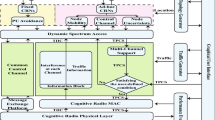Abstract
Interest in Dynamic Spectrum Access (DSA) remains powerful as the communications community efforts to solve the spectrum congestion problem. However, the basic problem of control channel is one that impediment the deployment of such dynamic networks. Now many studies of control channel have shown that using spectrum holes to transmit control information is a common rule. While such rule is lacking in aspects below. Firstly, Second Users (SU) can not have a common spectrum hole as control channel which leads to low link of Second Users. Secondly, the arrival of Primary User (PU) is unknown which causes interruption on the use of control channel. In this paper, we identify and discuss the way to begin the initial communication and setup a Cognitive Radio network with no need of using spectrum holes to convey control information in multi-hop scenarios. Simulations and derivations can show the change of the performance on the front aspects.
Access this chapter
Tax calculation will be finalised at checkout
Purchases are for personal use only
Similar content being viewed by others
References
Zhao, Q., Sadler, B.M.: A survey of dynamic spectrum access: signal processing, networking, and regulatory policy. IEEE Signal Proc. Mag. 24(5), 79–89 (2007)
Qiu, J.: Dynamic spectrum sharing strategy in cognitive radio systems. J. Beijing Univ. Posts Telecommun. 32, 2127–2159 (2009)
An, C.Y., Hong, J.I., Si, P.B., et al.: Dynamic control approaches of spectrum sensing in multi-band cognitive radio networks. J. Beijing Univ. Posts Telecommun. 17(5), 20–25 (2010)
Kondareddy, Y.R., Agrawal, P., Sivalingam, K.: Cognitive radio network setup without a common control channel. In: Akyildiz, I.F., Lee, W.Y., MILCOM, San Diego, pp. 1–6. Raytheon (2008)
Baldo, N., Asterjadhi, A., Zorzi, M.: Dynamic spectrum access using a network coded cognitive control channel. IEEE Trans. Wireless Commun. 9, 2575–2587 (2010)
Cormio, C., Chowdhury, K.R.: Common control channel design for cognitive radio wireless Ad hoc networks using adaptive frequency hopping. Ad Hoc Netw. 8, 430–438 (2010)
Jasbi, F., Daniel, K.C., et al.: Hybrid overlay/underlay cognitive radio network with MC-CDMA. IEEE Trans. Veh. Technol. 65(4), 2038–2047 (2015)
Wang, S.-F., Li, F.: A fast control channel selection algorithm for cognitive radio. J. Beijing Univ. Posts Telecommun. 34(5), 80–85 (2011)
Acknowledgments
This work was supported by the Key Development Program of Basic Research of China(JCKY2013604B001), the Nation Nature Science Foundation of China (61301095), Nature Science Foundation of Heilongjiang Province of China (F201408).
This paper is funded by the International Exchange Program of Harbin Engineering University for Innovation-oriented Talents Cultivation.
Meantime, all the authors declare that there is no conflict of interests regarding the publication of this article.
Author information
Authors and Affiliations
Corresponding author
Editor information
Editors and Affiliations
Rights and permissions
Copyright information
© 2019 Springer Nature Singapore Pte Ltd.
About this paper
Cite this paper
Han, H., Chen, X., Lin, Y. (2019). Novel Cognitive Radio Network Setup Mechanism Using Underlay as Control Channel to Enhance Efficiency. In: Liang, Q., Mu, J., Jia, M., Wang, W., Feng, X., Zhang, B. (eds) Communications, Signal Processing, and Systems. CSPS 2017. Lecture Notes in Electrical Engineering, vol 463. Springer, Singapore. https://doi.org/10.1007/978-981-10-6571-2_8
Download citation
DOI: https://doi.org/10.1007/978-981-10-6571-2_8
Published:
Publisher Name: Springer, Singapore
Print ISBN: 978-981-10-6570-5
Online ISBN: 978-981-10-6571-2
eBook Packages: EngineeringEngineering (R0)




